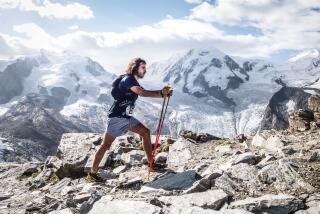100-Mile Run to Agony and Ecstacy
- Share via
It was a first for the grueling Angeles Crest 100-Mile Endurance Run: a third straight win for an Encinitas physical education teacher--and at best, a disappointing fourth place showing for one of the Tarahumara Indians from Northern Mexico who were running the race to call attention to their tribe’s plight.
Ben Hian, 27, finished in just over 18 hours and 50 minutes. Jennifer Henderson, 37, led the women, with a time of 24 hours and 26 minutes.
Of the four Tarahumara Indians who were competing to bring public notice to the malnourished tribe, two had to drop out after 75 miles. The fastest, Madero Herrera, 25, finished fourth, trailing Hian by about two hours.
Many in Sunday’s race were satisfied to have finished at all.
Runner John Canby of La Canada Flintridge had been plodding on his feet most of the previous 29 hours when finally, at 11 a.m., he walked across the finish line, bowlegged, stepping as if walking on broken glass. His first request to friends: Could they pull the car closer to him, please, so he could escape without having to take another step?
Some of the endurance runners concede that this equivalent of four back-to-back marathons may seem a bit nutty to outsiders.
Frank Pitts, 65, began to ponder this point around midnight Saturday, as he ran up and down mountains in the wilderness darkness. Below, he could see the twinkling city lights.
*
“I thought: ‘I could be in a nice soft bed,’ ” he said, quickly adding, “Then I thought: I’m out here having fun and all those people aren’t.” Pitts acknowledges some disadvantages to such a race, his eleventh: Sometimes, in the dead of night, running, he hallucinates. During one race, he was convinced that he had to take a train between two first aid stops along the route.
“Your legs feel like they’ve been beaten by baseball bats. You can’t imagine taking another step. Yet you have to keep moving. And somehow you do,” Pitts said. The retired Los Angeles County machinist, who began endurance running when he was 52, trained six to eight hours a day for the event.
Pitts, who had to drop out at the 74th mile Sunday but has finished the race six times before, plans to try again next year.
No matter one’s age or fitness, the rocky trail is grueling, with eight major peaks, a total climb of 21,610 feet, and then 26,700 feet of quad-busting descent. Of the 140 who started the race Saturday, 18 finished in less than 24 hours. One Tarahumara Indian lost eight pounds in the first 75 miles.
And there are real dangers: rattlesnakes at night, and in the 1992 race, a mountain lion. Hian had to grab the arm of his “pacer” and yank him back from the edge of a precipice on the narrow trail.
*
Pacer John Demorest, 45, of Colfax, Calif., recalls the 1990 run alongside one woman who took eight hours to cover 10 miles, stopping every 10 minutes to try to throw up. She spent three days in intensive care after the race.
Winner Hian, who runs a dozen 100-milers per year, lost three toenails in this race. He jumped over one rattlesnake, and during a training session, encountered a black bear and her two cubs.
Then, there are the dangers the mind conjures. Hian, like others, describes hallucinations; for him, it was a polar bear.
The biggest disappointment, perhaps, came to the Tarahumara Indians, who all developed chest pains. “They ran so fast they got dehydrated and got in trouble,” said Hal Winton, co-director of the race. Other runners drank water and noted that the Indians drank beer and a corn-based drink served in dried gourds.
One, Gabriel Bautista, rubbed his chest and said he didn’t understand the pain that forced him to drop out. “There are a lot of mountains. It’s very difficult,” he said, clearly devastated by the loss.
At daybreak, two dozen race watchers, many still ensconced in sleeping bags rimming the finish line, screamed, “All right!” and “You’re a real man!” as Garry Curry straggled to the end of the race.
During the last quarter of the race, the ascent up Mt. Wilson, Curry, 42, a Boulder, Colo., home builder, threw up, and finally, when he couldn’t take it any more, he lay down in the dirt and slept--six times in all.
Still, he has run this race every year since it began, 11 years ago.
“Adventure. The challenge. A lot of people do it because it satisfies their ego,” said Curry, who runs three such races a year. “It’s usually a lot of fun for the first 60 or 70 miles.”
Unlike shorter marathons, runners in 100-mile races help one another out, often talking others through rough spots, sharing water and crew help. Some go even further. Katsuyuki and Hiromi Hatta, who live in Japan, met while running an endurance race. On Sunday, after training 80 to 100 miles a week together, they ran the Angeles Crest 100-miler as a married couple.
*
Unlike marathons, longer runs require runners to eat and drink constantly if they expect to finish. Paul Braun, 34, of Encinitas scarfed six peanut butter and jelly sandwiches, three turkey sandwiches, lots of corn chips, chocolate chip cookies, protein drinks, and chicken soup. The total count: 15,000 calories in about 30 hours.
Before crossing the finish line as No. 29, Braun paused to kiss his wife, Andrea. It was the first time the commercial real estate broker had finished a 100-mile race. “29th! I can’t believe it!” his wife sobbed happily.
Despite being seven months pregnant, she ran the last half a mile with her husband.
As Lisa Deaton, 43, crossed the finish line with two friends holding her hands, her husband, Demorest, yelled, “Her feet are total hamburger!” A large blister under her heel had broken and peeled off. It was bleeding.
Overcome by emotion, Deaton often cries as she runs, and when her husband cries as he runs with her, they must run separately or risk choking up so badly they can’t keep running.
Usually, 50% to 60% of those who start finish the race, Winton said. Sunday’s is one of about 20 endurance races throughout the country each year. Such races, Winton said, were launched in the early 1980s when a horse in a 100-mile Northern California horse race went lame, and the rider wanted to see whether he could run it instead.
The worst of them may be Colorado’s Hard Rock run. Sunday finisher Diane Ridgway, a Denver nurse, said the average elevation is a lung-sapping 11,000 feet, along sheep trails. She finished that one in just under 45 hours--after hallucinating that the ground was strewn in comic book covers featuring the Fantastic Four and Superman.
More to Read
Go beyond the scoreboard
Get the latest on L.A.'s teams in the daily Sports Report newsletter.
You may occasionally receive promotional content from the Los Angeles Times.










